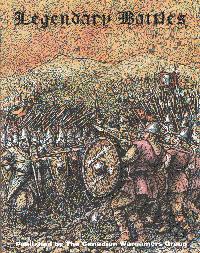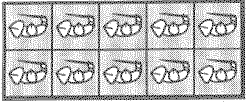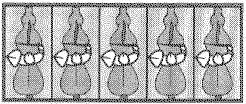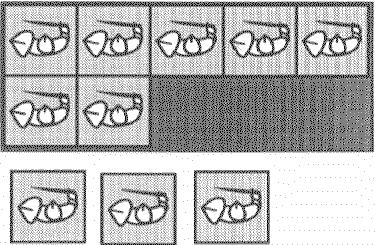
Legendary Battles

- Description
- Detailed Description
- Reviews
- Links
Back to FANTASY MASS-COMBAT RULES
In his Editor's Notes, Keith Martens explains the problems with other fantasy rules:
| Sadly, the rules sets to date cannot resist going totally overboard with chrome-laden rules which reduce games to glacial-paced affairs where the winner knows the greatest number of trick moves or simply out argues his opponent. |
The designers' intent in creating Legendary Battles was to create an enjoyable miniatures game which rewarded good tactics, yet didn't bog down due to convoluted rules or lead to arguments about what the rules were supposed to mean.
The Armies
Armies in Legendary Battles are built according to a point system, which allows their strengths to be totaled and compared. That is, any two armies of the same total point cost should be equal on the battlefield. (The designers put the system through over a million computer-simulated battles while fine tuning the point costs.)First, the player must select an Army Type. The possibilities are:
| Bretonnian | Medieval human army, composed of heavy cavalry, retainers, soldiers, peasants, bowmen and crossbowmen. |
|---|---|
| Dwarf | Slow-moving army, made up of Clan Guards (heavy infantry) and Clan Warriors, crossbowmen, and the elite Berserkers. |
| Empire | "Late medieval" style human army, with knights (on horse and foot), pikemen, soldiers, militia, and crossbowmen. |
| High Elf | Lightly armored force, composed of High Lords, guards, warriors, archers, and mercenaries. |
| Orc | The orcs come as cavalry (riding boars or wolves) and infantry (fighters or shooters), supported by hobgoblins and goblins. |
| Wood Elf | Very lightly armored, this force is made up of Forest Lords, guards, warriors, rangers, and mounted archers. |
The total number of units determines how many units the player receives of the basic troop types. However, some of these can be "cashed in" for other troop types.
EXAMPLE: Let's say that I'm putting together a 2,500 point Wood Elf army. According to the army chart, I have to take at least 3 units in this army. The basic troops are Warriors (lightly armored, "average" soldiers) and Rangers (very light armor, fast, low morale, function both as archers and swordsmen, have special Skirmishing ability). If I buy at least 4 units, then I'll automatically get at least one unit of Forest Guards (very light armor, fast, high morale, melee weapons). I can trade in up to half of my Ranger units for Forest Riders (very light armor, mounted archers/swordsmen, low morale, have special Skirmishing ability). Since the army list always gives me plenty of Rangers, this is a useful option. Trading in half of my Forest Guards for Forest Lords (light armor, mounted, high morale) is also an option. However, this isn't a real option unless I have at least two Forest Guards, and that requires an army of at least 8 units in size. In this case, I choose to go with 5 units in my army. That automatically gives me 2 units of Rangers, 2 Warriors, and 1 Forest Guard. I trade in one of my Rangers to get a single unit of Forest Riders, so my final organization is --
|
The cost for the unit depends upon the weapons chosen, and the number of bases per unit. (In 25mm, the number of bases is the same as the number of men; in other scales, more figures are mounted per base.)
For each unit type, there is a minimum and maximum number of stands per unit. For instance, you always have to take at least 20 stands in a Goblin unit, but that same number is the maximum allowed per unit of Empire Knights.
EXAMPLE: Of my five units, most of them provide me with no options (the Wood Elf army list is unusual in this respect) -- Forest Guards are always armed with "mixed weapons," and both Rangers and Forest Riders are always given swords and longbows. For the Warriors, however, I have four options:
In my case, I decide to go with one unit armed with Spear and Shield, and one unit with the basic Additional Weapon. In deciding how many stands to have of each unit, it's convenient to start with 10 stands in each unit, then buy in units of 10 until all of the points have been spent. (It's not necessary to buy stands in units of 10, just convenient.) My final army cost works out to be:
| ||||||||||||||||||||||||||||||||||||


The Sequence of Play
As the game proceeds, players alternate taking turns. Each Turn is composed of three steps:
| Movement Phase | Consists of three sub-phases: | |
|---|---|---|
| Engagement | Player can move his units into contact with enemy units. | |
| Maneuver | Player can move his other units. | |
| Reform | Player can attempt to restore Disordered stands. | |
| Missile Phase | Player declares all ranged attacks, then resolves them one by one. | |
| Melee Phase | All units (of both players) in contact with one another must fight. | |
| Flank Attacks | Units which just made a flank attack get a "free" attack | |
| General Combat | All other units make their attacks | |
| Morale | Heavily injured units must pass a Morale Test. | |
Movement
Movement is pretty straightforward. As the designers explain:
In medieval times, armies were mostly organized mobs. We would rather that the players concentrate on being in the right place rather than in the right formation. We have assumed that the units will take the most advantageous formation they can muster.Each unit can only take an action during one of the Movement sub-phases.
During the Engagement step, units can advance into melee combat with enemy units. This is the only time when units can approach so closely; during normal movement, each enemy unit has a "forbidden zone" of 4" on all sides, in which movement is prohibited.
A unit may be engaged in melee combat by only four units at a time (one per side). If an enemy doesn't have an unengaged side facing the potential attacker, no contact can be made.
Advancing into contact from "behind" an enemy unit counts as a Flank Attack, and entitles the attacker to a special attack during the Combat Phase. Once in contact, an attacking unit's position is "adjusted" so that it centers upon one of the enemy unit's sides. Now that it is engaged in combat, there is no way to retreat until one unit or the other is out of play!
During the Maneuver sub-phase, units pick a direction and move up to their maximum allowed distance. Their final facing is always perpendicular to the direction of movement. However, units are allowed to "line up" with certain terrain obstacles, such as walls or elevation levels.
Moving through difficult terrain can, depending upon the terrain type, reduce total movement for that turn and/or cause part of the unit to become Disordered.
Combat
Combat comes in two forms -- archery attacks (during the Missile Phase), and melee attacks (during the Melee Phase).Missile Combat. The attacker must declare all attacks before resolving the consequences; however, he is allowed to pre-measure distances, if he likes. Each unit can attack one enemy unit. Only unengaged units can make missile attacks.
Most units can only make missile attacks against enemy units in front of them (within their field of view). However, mounted archers and units designated as Skirmishers can attack any enemy in range. Only unengaged enemy units can be targeted.
For each attack, a unit's Firepower (the number of dice rolled) is a function of the number of stands in the unit. If the unit didn't move, it gets dice equal to half its stands; if it moved, it gets dice equal to only one-fourth the number of stands.
(Skirmishers are a special case, being able to fire on the move without penalty.)
The To Hit Number is determined by subtracting the target unit's Armor Class from the attacking unit's Fire Factor. Fire Factor depends upon the unit's type and the range.
For each successful hit in missile combat, one stand of the enemy unit becomes Disordered. Once all of the stands are Disordered, further missile hits will eliminate stands.
EXAMPLE: During a battle involving my Wood Elf army, my Forest Riders (20 stands) find themselves within short range (16" or less) of a Hobgoblin unit (10 stands). Since my Forest Riders are skirmishers, I get attack dice equal to one-third of the number of stands (regardless of movement). 20 / 3 = 6 attack dice (round down). The To Hit number is the Riders' Fire Factor ("9" at short range) minus the Hobgoblin's Armor Class ("2"): 9 - 2 = 7. Rolling six 10-sided dice, the results are: 2, 2, 3, 5, 6, 10. Only one roll was greater than or equal to the To Hit Number (7), so only one hit is scored. One Hobgoblin stand becomes Disordered. |
A unit which made a Flank Attack during the preceding Movement Phase gets to make its melee attack first. The defending unit does not get to attack this attacker during the current turn.
When resolving an attack, the player rolls a number of dice equaling the number of stands in the unit allocated to this attack, but never exceeding ten (the maximum number of troops which can be brought to bear).
The To Hit Number is determined by taking the attacker's To Hit score (based on weapon and troop type) and adding the defender's Weapon Skill (also based on weapon and troop type). A hit is scored for each roll equal to or greater than the To Hit Number.
The defending unit then gets to make its saving throws. The Save Number is the attacker's Strength (weapon damage) plus the defender's Armor Class. For each successful saving throw, one hit is negated.
Remaining hits result in the elimination of enemy stands. Disordered stands are eliminated last.
EXAMPLE: On a subsequent turn, a unit of Goblins (40 stands) engages my Forest Riders (20 stands). This was not a flank attack, so both units make attacks during the Melee Phase. Both players can only roll 10 dice (the maximum allowed, despite the number of stands on both sides). The To Hit Number for the Wood Elves is "1" (sword) plus the Goblins' weapon skill ("5" for their spears), for a final target of 1 + 5 = 6. Rolling 10 dice, I get 1, 1, 3, 5, 6, 7, 7, 9, 9, 9 -- good enough for six hits. The Goblin gets six saving throws, the target number being the Wood Elf Strength ("3") plus the Goblins' Armor Class ("3"): 3 + 3 = 6. He rolls 1, 1, 4, 5, 9, 10 -- two saves, leaving four remaining hits. For the Goblin attack, his To Hit Number is 8 (To Hit of "3" plus Weapon Skill of "5"). His 10 dierolls are 1, 3, 3, 5, 7, 8, 9, 9, 10, 10 -- five hits. My save number is 7 (his Strength of "3" plus my Armor Class of "4"). Rolling five dice, I get 2, 3, 6, 8, 10 -- two saves. In the end result, I remove four stands from my Wood Elf unit, and he removes three Goblin stands. |
Disorder and Morale
The stands within a unit can become Disordered as the result of missile fire, or due to moving through difficult terrain. A Disordered stand is removed from the movement tray, and trails behind the unit.

Disordered stands can be recovered during the Movement Phase, if the unit is unengaged and didn't move. If the dieroll is greater than or equal to the unit's Unit Morale (determined by troop type), one stand is recovered. Only three dice can be rolled per turn.
Units which have taken heavy casualties (more than 60% of their original strength) must pass Morale at the end of the Melee Phase. One roll is made per stand. Disordered stands which fail their roll are removed from play; other stands which fail become Disordered.
Magic
A basic magic system is provided in Legendary Battles as an optional rules system; an advanced magic supplement is planned for some future date.Each army may have one magic-user, equipped with a number of wizard points based on the point cost of the army he is part of. The points have a dual function -- they are expended to cast spells, but they are also the hit points of the wizard (he is out of play when no points remain).
The spells provided in the basic magic system are:
| Attack Spells | Magic Missile |
|---|---|
| Flame Strike | |
| Lightning Bolt | |
| Fireball | |
| Recovery Spells | Enthusiasm |
| Courage | |
| Valour | |
| Esprit de Corps | |
| Protection Spells | Shield of Resistance |
| Aura of Protection | |
| Globe of Invulnerability | |
| Impedance Spells | Magic Bog |
| Swampy Trail | |
| Field of Mud | |
| Psionic Attack Spells | Strength of Will |
| Mind Blade | |
| Finger of Death |
Player Aids
The rulebook includes a number of blank forms, as well as the movement tray template mentioned earlier. Especially convenient is a "battle form" (a note-sized form) -- the idea is to write down the combat numbers during the first combat phase, then place that tag next to the combat. (The various To Hit and Save numbers won't change.)As an optional rule, an Averaging Table is provided. Instead of rolling large numbers of dice, players can instead index the number of attack dice against the chart to determine the average hit chance. The result is given as a number of hits, plus a chance to score one additional hit.
The Tournament System
The designers of Legendary Battles have created this game with the intent that it could be used for competitive gaming, if desired.As mentioned previously, a computer simulation was used to fine tune the army lists, so that equal point-cost forces would be equally effective on the battlefield.
The rules describe several ways to organize tournaments, and provide sample 2,500-point armies and several battle maps. Suggestions are made for designing a good tournament scenario.